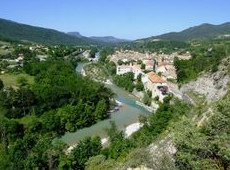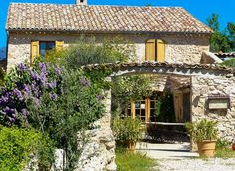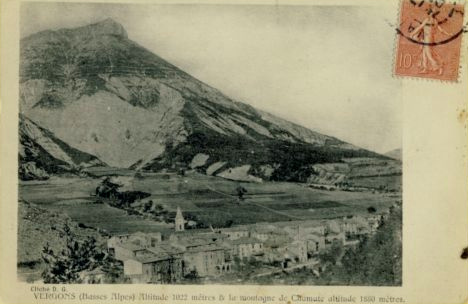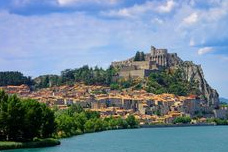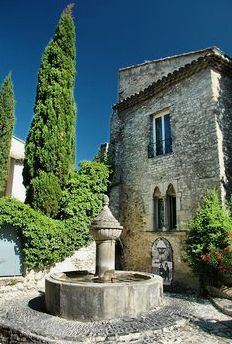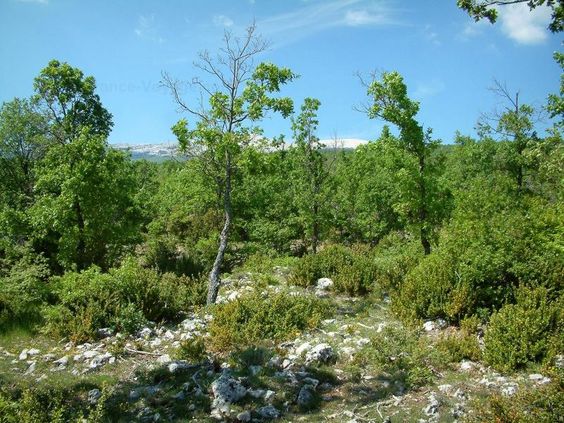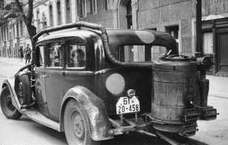2c) The legend about Bouffier - the
original text - translation
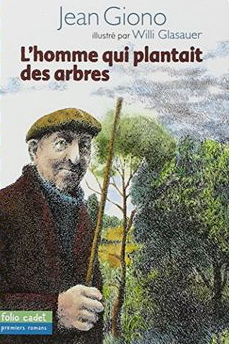
Book "The man who planted
trees", original French:
"L'homme qui plantait des arbres" [1]
Jean Giono
The man who planted trees
Edition BeQ [p.1]
Jean Giono
The man who planted trees
Electronic Library of Quebec
Classic collection of the 20th century
Volume 49: Version 1.01
http://permaculteur.free.fr/ressources/Giono-arbres.pdf
[p.2]
In order for a person's character to reveal truly
extraordinary qualities, one must be fortunate enough to
be able to observe his actions over many years. If the
actions contain no egoisms, if the guiding idea of
generosity is unprecedented, if one can be absolutely
certain that no reward has been sought anywhere through
the actions, and if these actions have left visible traces
in the world, then we are undoubtedly faced with an
unforgettable character. [p.3]
The walk in the barren Southern Alps - abandoned and
dilapidated villages
About forty years ago [in 1913], I walked for a long time,
on completely unknown heights, in this very ancient region
of the Alps that stretches as far as Provence.
This region is bordered in the southeast and south by the
central section of Durance River between the locations of
Sisteron and Mirabeau; in the north by the upper part of
the department Drôme, from the beginning as far as to the
village of Die; in the west by the plains of the Comtat
Venaissin and the hills of Mont Ventoux. It covers the
entire northern part of the department of Basses-Alpes,
the south of the department of Drôme and a small enclave
of the department of Vaucluse.


Bouffier's sphere of action from
Durance River to Drôme River - with the marking of the
forest area [2,3]
Durance River Durance at Manosque
[4] - Durance Valley in High Provence (Haute Provence)
[5] - Drôme River at Saillans below the location of
Die [6] -River Drôme with kayakers
[7]
When I started my long walk in these barren areas, they
were naked and there were monotonous moors, at an altitude
of about 1200 to 1300 meters. Only wild lavender grew
there [p.4].
Lavender field in the Drôme valley
[8] - the location of Vergons around 1910 - the mountain
is practically WITHOUT forest [9]
I crossed this region in the broadest sense and after
three days of walking I found myself in a bleak situation
without example. I camped next to an abandoned village
that was abandoned and half dilapidated, like a skeleton.
I hadn't had any water since the day before and had to
find some. These houses, although in ruins, like an old
wasp nest, made me think that there must have been a
fountain or well there in the past. There was a well, but
it was dry. The five to six houses, without roofs, gnawed
to pieces by wind and rain, the small chapel with its
collapsed bell tower, could only be seen in it's outlines.
All this was arranged in the same way as in other villages
where there was still life. But here all life had
disappeared.
It was a beautiful day in June with lots of sunshine, but
in this area without shelter so close to the sky the wind
blew with unbearable brutality. His rumbling in the ruins
of the houses was like a wild animal that was protesting
against being disturbed during his meal.
The shepherd, his farm, his well
Country house in Provence [10] - A
shepherd with a flock of sheep in Castellane going up to
the Alps, High Provence (Haute Provence) [11]
I had to leave my campsite. Five hours later [p.5] I had
still not found any water and there was no hope of finding
it. Everywhere the same drought was prevailing, the same
woody grasses were dominating. Then I saw something like a
little black figure in the distance. I thought it was the
trunk of a lonely tree. By chance I approached it. It was
a shepherd. With him about thirty sheep lay on the warmed
up ground.
He let me drink from his drinking bottle, and a little
time later he led me to his sheepfold, which lay in a
depression of the plateau. He drew his water from the well
- excellent water - from a natural, very deep hole, over
which he had installed a rudimentary winch.
This man spoke little. This is the habit of the loners,
but we felt full of confidence and trust in this place. It
was an unusual place in this region where hardly anything
grew. He did not live in a hut, but in a real stone house,
where one could see very clearly how his work worked
[p.6].
He had renovated a ruin he had found there. The roof was
solid and waterproof. The wind hit the house and made a
rushing sound on the tiles like on a beach.
His household was fine, his dishes were washed, his
parquet floor was swept, his gun was greased; his soup
cooked on the fire; I noticed then that he was also
freshly shaved, that all his buttons were tightly sewn,
that his clothes were patched with meticulous care so that
the repairs were invisible. [Thei were not so invible,
so...]
He shared his soup with me, and when I made a joke about
smoking, he said he didn't smoke. His dog, who was as
quiet as he was, was benevolent, without malice.
It was immediately clear that I would spend the night
there; the next village was still more than a day and a
half away on foot. And I was also very familiar with the
character of the few villages in this region. There are
four or five scattered places here [p.7], far apart on the
sides of these heights, in the white oak forests at the
ends of the trafficable roads. They are inhabited by
lumberjacks who produce charcoal. These are places where
people do not have a good life. Families who have to live
together in this extremely harsh climate, both in summer
and in winter, spoil their selfishness in a vacuum. The
result is an inappropriate ambition, a constant desire to
flee from this place. The men bring their coal with their
trucks into the city and then return. The strongest people
break under this eternal Scottish shower. Women are
planning revenge actions. Everything is in competition,
both in the sale of the coal and on the bank in the
church, because of the virtues that fight each other,
because of the vices that fight each other, and because of
the general hustle and bustle of vices and virtues, there
is no rest. Moreover, the wind also irritates the nerves.
There are epidemics [p.8] with suicides and many cases of
madness, it is almost always ending fatally.
Sorting acorns - making holes with an iron rod -
setting acorns
Acorns with oak leaves [12] - Mount
Ventoux (Mont Ventoux), karst and woods, 1909m above sea
level [13]
The shepherd who did not smoke fetched a small bag and
spread a pile of acorns on the table. He began to examine
them one by one with great attention and separated the
good ones from the bad ones. I smoked my pipe. I offered
to help him. He told me it was only his business. Indeed,
given the care he has taken in this work, I did not insist
on helping. That was our whole conversation. When he had a
heap of quite large acorns on his good side, he counted
them in packs of ten. He still eliminated small acorns or
those that were slightly torn, as he examined them very
carefully. When he had a hundred perfect acorns in front
of him, he stopped and we went to bed.
This man's company gave peace. The next day I asked him
permission to rest with him all day long. He found it
natural. Or more precisely, he gave me [p.9] the
impression that nothing could bother him. This break was
not absolutely necessary for me, but I was fascinated and
wanted to learn more from him.
[The next morning] he let his flock out and led it to the
pasture. Before he left, he soaked the small bag [with the
acorns] in a bucket of water, where he had put the
carefully selected and counted acorns the night before.
I noticed that as a stick he carried an iron bar which was
as thick as his thumb and about one and a half meters
long. I was rested and walking parallel to him on a
street. The pasture of his animals was in the background
in a gorge. He left the small herd in the care of the dog
and came to me. I was afraid that he would blame me for my
indiscretion, but not at all: that was his way and he
invited me to go with him when I had nothing better to do.
He went two hundred meters further, up the hill.
When he reached the spot where he wanted to go, he began
to stick his iron rod into the ground [p.10]. He made a
hole in which he put an acorn, then he closed the hole
again. He planted oaks. I asked him if the land belonged
to him. He answered no. Did he know who owned it? He did
not know. He assumed it was community land, or maybe it
belonged to people who didn't care. He didn't care to know
the owners. He simply planted a hundred acorns with the
utmost care.
10,000 out of 100,000 oak trees grow
Haute-Provence, young oak forest on
white karst soil with Mont Ventoux in the background
[14]
After lunch he started sorting his seeds again. I think my
questions weren't stupid because he answered them. For
three years he has been planting trees in this solitude.
He had planted a hundred thousand of them. Of the hundred
thousand, twenty thousand had risen. Of these twenty
thousand, he still expected to lose half of them because
of animals eating them or because of other difficulties,
which could not be predicted even with the best
providence. So out of 100,000, 10,000 oaks remained, which
continued to grow in this place where there had been
nothing before [p.11].
Then I was worried about the age of this man. He was
obviously over fifty years old. Fifty-five, he said to me.
His name was Elzéard Bouffier. He had owned a farm in the
plains. He had realized his life there. He had lost his
only son and then his wife. He had retreated into
solitude, where he enjoyed living slowly, with his sheep
and his dog. He had realized that this land would die
because of lack of trees. Since he had no very important
professions, he decided to improve this situation.
At that time, despite my young age, I knew how to deal
tenderly with the soul of a person living alone. But I
made a mistake. Especially at a young age I had to imagine
the future in terms of myself and a certain search for
happiness. I told him that these ten thousand oaks would
be great in thirty years. He simply replied to me that if
God gave him thirty more years of life, he would plant so
many more trees [p.12] that those 10,000 would be like a
drop in the sea.
He was already studying beech growing and had set up a
tree nursery near his house, the beech trees of the
beechnuts. The new trees, protected from the sheep by a
wire fence, grew nicely. And on soils with humidity
underground one should plant birches, he said to me. The
next day we separated.
First World War 1914-1919
The following year the First World War began, in which I
had to serve for five years. An infantry soldier could
hardly think of trees. To be honest, this very thing had
left no trace on me; I had taken it for a tick, like a
stamp collection - and forgot.
After the war [in 1919] I was at the top for a tiny
demobilization bonus, but I also had a strong desire to
get some fresh air. [p.13]
Without any preconceived opinion - except this - I
returned to this abandoned region.
The country had not changed. But behind the dead village I
saw in the distance a kind of grey fog that covered the
heights like a carpet. Already the day before I had
started to think again about this tree-planting shepherd.
"Ten thousand oaks", I thought to myself, "really do
occupy a very large space.
The new oak forest at Mont Ventoux - 11 kilometres
long, 3 kilometres wide
Mount Ventoux (Mont Ventoux) 02 [15]
The last five years [during the war], I had seen too many
people die, but I could not imagine the death of Elzéard
Bouffier so easily, especially since the men of twenty are
regarding the men of fifty as old men. He was not dead. It
was now even very green there. He had changed his job. He
had only four sheep left, but now he had about a hundred
beehives. The sheep kept feeding from his trees, so he had
to get rid of the sheep. He also told me (and I noticed
it) that he wasn't interested in the war at all. He had
continued planting without interruption. [p.14]
The oaks of 1910 were ten years old now and bigger than me
and him. The show was impressive now. I was literally
robbed of my voice, and since he did not speak, we spent
the whole day in silence in his forest. It was now divided
into three sections - a total of eleven kilometres long
and three kilometres wide. We celebrated together that
everything had come from this man's hands and soul -
without technical means. We understood that people in
areas other than destruction could be as effective as God.
He had followed his idea, and the beeches that reached my
shoulders and spread as far as the eye could see were the
witnesses. The oaks were thick and old enough not to be
eaten by animals anymore. If Providence now wanted to
cause damage, then hurricanes were necessary now. He
showed me some admirable birch groves that were five years
old [p.15], that is, they had been planted in 1915 - at
that time I had fought at Verdun. He had planted these
birches everywhere he suspected damp ground. Now they had
grown tenderly, at a young age, and were very determined.
Creation [with it's wars], by the way, was more in the
direction of encircling and chaining itself. He didn't
care; he stubbornly pursued his task, which was very
simple. But as I descended through the village, I saw
flowing streams that had always been dry since time
immemorial. It was the most amazing reaction operation I
have ever seen. These dry streams had once carried water
in ancient times. Some of these sad villages, which I
mentioned at the beginning of my story, were built on the
sites of ancient Gallo-Roman villages, of which there were
still traces. Digging archaeologists had still found
fishing hooks in these villages, which testified to the
fact that one could fish here once - that was not to be
thought of until the 20th century [p. 16].
People lived off the water tank.
The wind was also involved in forest formation and
scattered some seeds.
New sources, new water, new life
When the springs and water came back, pastures, meadows,
gardens, flowers and the reason for life appeared.
But the transformation was so slow that it became a habit
without causing any surprise. The hunters who went into
solitude hunting for hares or wild boars had noticed the
abundance of small trees, but they had attributed it to a
natural whim of nature. Therefore, no one has seen this
man's work. If they had suspected him, they would have
angered him. He was unexpected. Who in the villages and in
the administrations could have imagined such a
stubbornness being combined with the greatest generosity?
A crisis year: 100,000 maple trees are not coming
Since 1920, not one year has passed [p.17] without a visit
to Elzéard Bouffier. I have never seen him weak or
doubtful. And yet, God knows whether God will even push
this forward! I have not counted his setbacks. However, it
is easy to imagine that for such a success it was
necessary to overcome adversity; that in order to secure
the victory of such a passion one had to fight with
despair. During one year he had planted more than ten
thousand maples. They all died. The following year he let
be the maples to return to the beeches, which were even
better than the oaks.
In order to have a more or less precise idea of this
extraordinary character, we must not forget that he
practiced in complete solitude; so much so that towards
the end of his life he had lost the habit of speaking. Or
perhaps he didn't see the need for it?
1933: A forester - and a stone hut 12km away
Stone hut / shepherd's hut at Mount
Ventoux (Mont Ventoux) [16]
In 1933 he received a visit from an astonished forester.
This official ordered him not to make a fire outside for
fear that this natural forest might burn down [p.18].
"It is the first time", this naive man said, "that we see
a forest growing alone." At that time he wanted to plant
beech trees twelve kilometres from his house. To avoid the
round trip - because he was seventy-five now - he planned
to build a stone hut on the site of his plantations. Which
he did the following year.
1935: A forester boss and a picnic
Wooded Nesque Gorge near Mount
Ventoux [17]
In 1935 a real administrative delegation came to
investigate the natural forest. There came a big fish,
responsible for water and forest, a deputy, and a few
engineers. Many useless words were spoken. They decided to
do something, and fortunately nothing was done except the
only useful thing: to put the forest under state
protection and forbid anyone to come here to produce coal
from it. Because it was impossible not to be surprised by
the beauty of these healthy young trees. And this beauty
exercised its seductive power over the deputy himself.
[p.19]
I had a friend among the forester bosses who was part of
the delegation. I explained the secret to him. The
following week, one day, we both went in search of Elzéard
Bouffier. We found him at work, twenty kilometres from
where the inspection took place.
This chief forester was not my friend for nothing. He knew
the value of things. He knew how to be silent. I offered
the few chicken eggs I had brought as a gift. We shared
our three-hour picnic, and then spent a few more hours
quietly contemplating the landscape.
The side from which we came was covered with six to seven
meter high trees. I still remembered what the landscape
had looked like in 1913: like a desert..... The peaceful
and regular work, the living air of the heights, the
thrift and above all the serenity of the soul had given
this old man an almost solemn health. He was an athlete of
God. I wondered how many hectares [p.20] he would still
forest.
Before I left, my friend made a brief suggestion about
some of the tree species for which the area seemed
suitable. But he did not insist on it. "For good reason"
he told me afterwards, because "this man knows more than I
do." After an hour's walk - the thought had solidified
with him - he added: "He knows much more than anyone else.
He has found the Big Path to be happy!
It is thanks to this forester chief that not only the
forest, but also the happiness of this man was protected.
He had three forester guards appointed for this protection
and controlled and instructed them so that they remained
immune to all the bribes of the lumberjacks.
1939-1945: Short danger for the forest at Mont Ventoux
because of wood gas - but it was unprofitable
Wood gas car [18]
Only during the war in 1939, there was a serious danger
for this work. Cars were run on wood gas and there was
never enough wood. They began felling the oaks [p.21] of
1910, but where they were felling and carrying the trunks
out this was so far from any road network that the project
turned out to be very bad financially. The forest was kept
in peace. The shepherd had not seen anything. He was
thirty kilometers away continuing his work peacefully and
ignored the war of 1939, just as he had ignored the war of
1914.
June 1945: The transformation of the villages in the
Mount Ventoux region - example Vergons: fragrant breeze,
forest noise, rippling water, vegetable garden with
flowers
Vergons at around 1910 - the mountain
is practically WITHOUT forest [9] - Vergons of around
2010 ca.: ALL mountains have FOREST [19]
I last saw Elzéard Bouffier in June 1945. He was 87 years
old at that time. So I drove up the desert road again, but
now, despite the decay of the war, there was a bus
connecting the Durance Valley and the mountains. I hold
this relatively fast means of transport responsible for
the fact that I did not recognize the places of my first
walks any more. It also seemed to me that the route led me
to new places. I needed a village name to come to the
conclusion that I was still in this once ruined and
desolate region. The bus brought me to Vergons [p.22]. In
1913 this hamlet had ten to twelve houses and three
inhabitants [that might not be true, see the photo of
Vergons around 1910]. They were wild at that time, hated
each other and lived from hunting with traps: They were
more or less in the physical and moral state of the Stone
Age. Around the abandoned houses the stinging nettles grew
and devoured the houses. Their condition was hopeless. For
them it was only a matter of waiting for death: a
situation that hardly predisposed them to virtues.
But now everything had changed: Even the air. Instead of
the dry and brutal gusts that once welcomed me, a gentle
and fragrant breeze was blowing. From the height it was
roaring as if by the sea: it was the sound of the wind in
the woods. Finally, surprisingly, I heard the real splash
of water splashing into a well. I saw a newly built well
with plenty of water, and what really touched me the most
was a newly planted lime tree nearby, which had become
thick already after four years, an indisputable symbol of
a resurrection.
Moreover, in Vergons there were also traces of a [p.23]
new bustle which did not work without a certain hope. So,
hope had returned. The ruins had been removed, the
dilapidated walls had been demolished, and five houses had
been rebuilt. The village now [in 1945] had 28
inhabitants, including four young households. The new
houses, plastered with fresh plaster, were surrounded by
vegetable gardens in which vegetables and flowers,
cabbages and roses, leeks and snapdragons, celery and
anemones were growing, mixed but well-assorted. It was now
a place where people wanted to live.
From there I set off on foot. The war that we had just
brought behind us allowed only a limited life, but Lazarus
was out of the grave. On the lowered sides of the mountain
I saw small barley and rye fields in the grass; at the
foot of the narrow valleys were some green meadows.
In only eight years a change to health and swinging life
had been realized [p.24]. In the place of the ruins which
I had seen in 1913, there are today [1953] clean,
plastered farms that show a happy and comfortable life.
The old springs, fed by rainfall and snow from the
forests, began to flow again. The water was also somewhat
canalized. Beside each farm, in maple groves, the well
basins are overflowing and irrigating the mint growing
near the well. The villages were gradually rebuilt. New
population from the plains, where the land prices were
high, have settled in the countryside bringing new
youthfulness, movement and adventure. On the way there we
met well-fed men and women, boys and girls, who knew how
to laugh and who had become interested in farmer festivals
again. Considering the old population, which now lived in
a gentle existence, and the new arrivals, they were no
longer recognizable. All in all, more than ten thousand
people owed their happiness to the shepherd and tree
planter Elzéard Bouffier. [p.25]
Sisteron with Durance River [20] -
the location of Vaison la Romaine, Haute Provence [21]
- the location of Die with wooded mountain range,
Département Drôme [22]
When I consider that a single man, reduced to his simple
physical and moral resources, is enough to turn the desert
into a promised land, I find that despite everything, the
human condition is admirable. But when I consider all that
it took to achieve this result in terms of the consistency
of spirit and the determination of generosity, I have
great respect for this ancient peasant without culture,
who knew how to do this work worthy of God.
Elzéard Bouffier died peacefully in the Hospice of the
location of Banon in 1947. [p.26]
This is the 49th published book.
in the classical collection of the 20th century.
from the electronic library Quebec.
This electronic library of Quebek (Bibliothèque
électronique du Québec)
is the exclusive property of
Jean-Yves Dupuis. [p.28]







